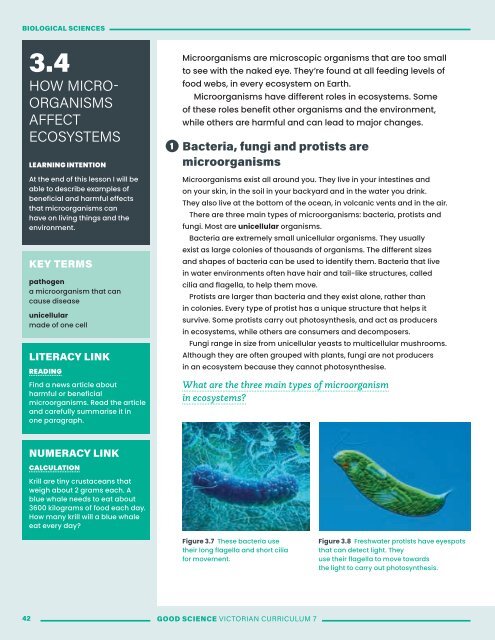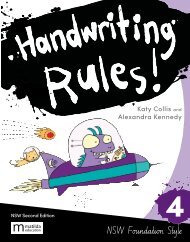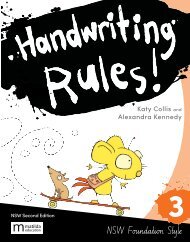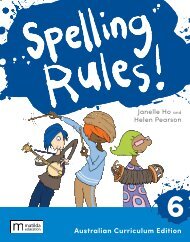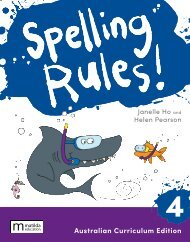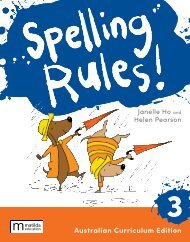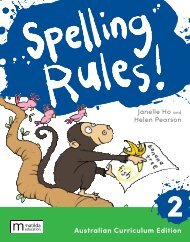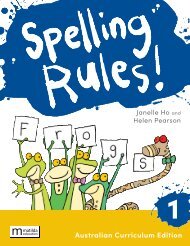Good Science Victorian Curriculum Year 7
Digital sample of Matilda's newest publication, Good Science Victorian Curriculum Year, authored by Emma Craven and Aaron Elias. For more information visit www.matildaeducation.com.au or email Katrina Tucker, katrinatucker@matildaed.com.au
Digital sample of Matilda's newest publication, Good Science Victorian Curriculum Year, authored by Emma Craven and Aaron Elias. For more information visit www.matildaeducation.com.au or email Katrina Tucker, katrinatucker@matildaed.com.au
Create successful ePaper yourself
Turn your PDF publications into a flip-book with our unique Google optimized e-Paper software.
BIOLOGICAL SCIENCES<br />
3.4<br />
HOW MICRO-<br />
ORGANISMS<br />
AFFECT<br />
ECOSYSTEMS<br />
LEARNING INTENTION<br />
At the end of this lesson I will be<br />
able to describe examples of<br />
beneficial and harmful effects<br />
that microorganisms can<br />
have on living things and the<br />
environment.<br />
KEY TERMS<br />
pathogen<br />
a microorganism that can<br />
cause disease<br />
unicellular<br />
made of one cell<br />
LITERACY LINK<br />
READING<br />
Find a news article about<br />
harmful or beneficial<br />
microorganisms. Read the article<br />
and carefully summarise it in<br />
one paragraph.<br />
1<br />
Microorganisms are microscopic organisms that are too small<br />
to see with the naked eye. They’re found at all feeding levels of<br />
food webs, in every ecosystem on Earth.<br />
Microorganisms have different roles in ecosystems. Some<br />
of these roles benefit other organisms and the environment,<br />
while others are harmful and can lead to major changes.<br />
Bacteria, fungi and protists are<br />
microorganisms<br />
Microorganisms exist all around you. They live in your intestines and<br />
on your skin, in the soil in your backyard and in the water you drink.<br />
They also live at the bottom of the ocean, in volcanic vents and in the air.<br />
There are three main types of microorganisms: bacteria, protists and<br />
fungi. Most are unicellular organisms.<br />
Bacteria are extremely small unicellular organisms. They usually<br />
exist as large colonies of thousands of organisms. The different sizes<br />
and shapes of bacteria can be used to identify them. Bacteria that live<br />
in water environments often have hair and tail-like structures, called<br />
cilia and flagella, to help them move.<br />
Protists are larger than bacteria and they exist alone, rather than<br />
in colonies. Every type of protist has a unique structure that helps it<br />
survive. Some protists carry out photosynthesis, and act as producers<br />
in ecosystems, while others are consumers and decomposers.<br />
Fungi range in size from unicellular yeasts to multicellular mushrooms.<br />
Although they are often grouped with plants, fungi are not producers<br />
in an ecosystem because they cannot photosynthesise.<br />
What are the three main types of microorganism<br />
in ecosystems?<br />
NUMERACY LINK<br />
CALCULATION<br />
Krill are tiny crustaceans that<br />
weigh about 2 grams each. A<br />
blue whale needs to eat about<br />
3600 kilograms of food each day.<br />
How many krill will a blue whale<br />
eat every day?<br />
Figure 3.7 These bacteria use<br />
their long flagella and short cilia<br />
for movement.<br />
Figure 3.8 Freshwater protists have eyespots<br />
that can detect light. They<br />
use their flagella to move towards<br />
the light to carry out photosynthesis.<br />
42 GOOD SCIENCE VICTORIAN CURRICULUM 7


